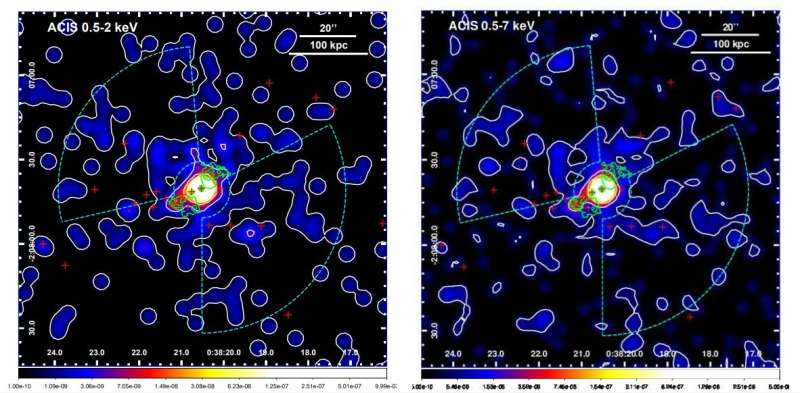Broadband 0.5 − 2 keV (left panel) and 0.5 − 7 keV (right panel) ACIS-S flux images centered on 3C 17. Image credit: Madrid et al., 2018.
Using the Gemini Observatory and NASA's Chandra spacecraft, a team of astronomers has provided new information about the radio galaxy 3C 17 and its environment. The observations show that 3C 17 is the brightest member of a newly found galaxy cluster. The finding is reported in a paper published October 18 on arXiv.org.
Radio galaxies emit huge amounts of radio waves from their central cores. Black holes at the center of these galaxies are accreting gas and dust, generating high-energy jets visible in radio wavelengths, which accelerate electrically charged particles to high velocities.
Radio galaxies are observed to interact with their environment in often spectacular ways. For instance, in some of them, jets emanating from the central black hole are bent due to supersonic ram pressure of the intracluster medium.
At a redshift of 0.22, 3C 17 (also designated PKS 0035–02) is a broad-line radio galaxy showcasing strong indications of interaction with its environment. Previous observations of this galaxy found that its radio morphology is dominated by a single-sided, dramatically curved jet.
The remarkable morphology of 3C 17's radio jet, and several unclassified sources along the jet's path, motivated a group of astronomers led by Juan P. Madrid of Commonwealth Scientific and Industrial Research Organisation (CSIRO) in Australia, to perform further studies of this galaxy. As part of their research, the team conducted observations of 3C 17 using the Gemini Multi Object Spectrograph (GMOS) of the Gemini Observatory, and analyzed observational data of this galaxy provided by NASA's Chandra X-ray spacecraft.
"An optical and X-ray study of 3C 17 and its environment was carried out using Gemini and Chandra data," the researchers wrote in the paper.
The observations allowed Madrid's team to identify a previously uncatalogued cluster of galaxies at a redshift of 0.22, with a projected virial radius of about 1.2 million light years, and a velocity dispersion of around 821 km/s.
They found that 3C 17 belongs to this cluster and that with an absolute magnitude of –22.45 it is the brightest cluster member. Furthermore, the study also revealed that 3C 17 is dominated by broad emission lines.
"Its surface brightness profile is best fit with a double component model characteristic of BCGs [brightest cluster galaxies]," the paper reads.
Moreover, based on the analysis of Chandra data, the scientists uncovered the presence of extended soft X-ray emission surrounding 3C 17. They assume that this emission most likely has its origin in the hot gas of the intergalactic medium.
In concluding remarks, the authors of the paper say that 3C 17's membership in a galaxy cluster explains its radio morphology. They noted that the jet of this galaxy is sharply curved as it propagates through a dense intracluster medium.
The researchers added that bent-tail radio galaxies like 3C 17 could be used by astronomers as signposts for distant galaxy clusters in wide-field radio-continuum surveys to be conducted in the future.
More information: Juan P. Madrid et al. 3C 17: The BCG of a galaxy cluster at z=0.22. arXiv:1810.08274 [astro-ph.GA]. arxiv.org/abs/1810.08274
© 2018 Science X Network
























